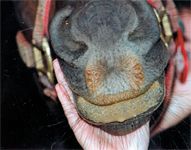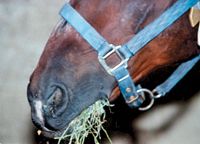Botulism in horses: Veterinarians should be cognizant in their diagnosis
Knowing what to look for and being diligent in gathering the patient's history will help veterinarians diagnose this often overlooked condition.
When exposed to the neurotoxin Clostridium botulinum, horses develop botulism, a disease of progressive flaccid paresis and cranial nerve deficits. The disease is almost always acquired in one of three ways: through the ingestion of preformed toxin with food (food-borne botulism in adults), through the ingestion of C. botulinum spores that subsequently germinate in the gastrointestinal tract and elaborate toxin (toxicoinfectioius botulism in foals) or through contamination of wounds with C. botulinum and subsequent bacterial growth with toxin release (wound botulism).1
According to Amy Johnson, DVM, DACVIM, assistant professor of large animal medicine and neurology at the New Bolton Center at the University of Pennsylvania School of Veterinary Medicine, botulism in horses is commonly seen in the mid-Atlantic states and Kentucky as serotype B and as type A in the western states, which include California, Washington, Oregon, Idaho, Montana, Wyoming and Nebraska. Type C is sporadically seen across the United States. Types A and B are associated with soil, and type C is associated with carrion. "Equine type B cases account for more than 85 percent of equine cases diagnosed in the U.S.," states Johnson.

Horses with botulism tend to drop food and saliva from their mouth and nose as they attempt to eat. (PHOTOS COURTESY OF DR. SUSAN MCADAMS-GALLAGHER, NEW BOLTON CENTER AT THE UNIVERSITY OF PENNSYLVANIA)
Early diagnosis is key
Johnson states that because botulism can easily mimic other diseases, such as esophageal obstruction (choke) or colic, it's important to always have it on your differential diagnosis list. Practitioners should focus on the types of cases in which they should consider botulism and differentiate it from other diseases. "Many veterinarians do not commonly see botulism cases in veterinary school," says Johnson. "And if they don't recognize the signs, they might not have it on their list and, therefore, not easily diagnose it."
Early diagnosis is key to providing appropriate treatment and, hopefully, saving the horse, but the signs aren't always clear-cut in the early stages of disease, says Johnson. "By the time the horse is recumbent and clearly very weak and dysphagic, it's easy to diagnose," she says. "But the horse that presents not eating very well and looking a little bit colicky, or the horse that's a little bit dysphagic without any other signs of weakness—those are the cases that may be missed."

The clinical signs of botulism often include difficulty eating and poor hay consumption due to lack of strong tongue tone.
Botulism vs. choke
Botulism can easily be mistaken for choke because frequently the horses will have food coming out of their mouths and noses. And though often they'll have weak tongue tone, it's not necessarily obvious in the very beginning, says Johnson.
One thing that can help differentiate botulism from a choke case is if the practitioner passes a nasogastric tube and it passes easily. There are some choke cases that can be relieved on the first pass, but if it appears that there's not a very significant obstruction, the practitioner should consider whether it's actually a botulism case, Johnson advises.

A grain test, which involves timing a horse to see how long it takes him to consume feed, can help diagnose botulism.
If botulism is suspected, a tongue stress test and a feed test can be performed to determine if it's dysphagia and not an esophageal obstruction. The tongue tone or tongue stress test is done by gently withdrawing the tongue from the horse's mouth and assessing the horse's ability to pull it back while holding the jaw closed. With botulism, the tongue will tend to hang, not having the strength to be easily retracted.
The feed or grain test involves feeding the horse eight ounces of grain in a bucket while timing how long it takes for the horse to consume the feed. Healthy horses finish their feed within two minutes, whereas horses with dysphagia do not. Not only do they not consume their feed easily, they also tend to drop their feed and release saliva from their mouth and nose as they attempt to eat, leaving a trail of saliva in the bottom of the feed tub.
"Not every botulism horse wants to eat," Johnson notes. "Some of them come in slightly depressed. They stop trying to eat, which is another reason that the disease is not so obvious when first presented."
That's when it's really important to critically evaluate the tongue, she says. Another possible clue to botulism is that the horses will often, but not always, displace their palates and display dysphagia. In a choke or colic case, that would be an unlikely finding.
Botulism vs. colic
It may be tough to differentiate botulism from colic, because horses with botulism are often lying down and not eating, and as a result, they may be designated as having colic.
"There have been several occasions, even at a place such as New Bolton Center, where a botulism case was sent to surgery [for colic]," Johnson says. "During surgery, no surgical lesions were found in the gastrointestinal tract. The practitioner then realized, after recovery, that it was botulism."
One clue to distinguish botulism from colic is that horses with botulism usually look worse standing up than lying down, Johnson explains. Additionally, they are often more agitated, have a higher heart rate when standing and have more muscle tremors. When they are lying down, horses with botulism tend to relax. They might not go into lateral recumbency, but even sternal, their muscle tremors stop and their heart rate decreases.
Also, unlike horses with colic, those with botulism don't do "flank watching" and frequently don't go back and forth between lateral and sternal recumbency as frequently as a horse with abdominal pain tends to do.
Another factor that distinguishes botulism from colic is the horse's response to an analgesic, says Johnson. "Giving a horse with abdominal pain an analgesic, such as flunixin, xylazine or detomidine, will usually lead to clinical improvement for the duration of action of the analgesic," Johnson states. "But in horses with botulism, you give them an analgesic and they don't necessarily look better. The tremors continue, and they may still lie down, as it is not affecting the muscle weakness, though it would affect the pain of the colicky horse. This exemplifies another finding to prompt putting botulism on your list."
Other distinguishing signs of botulism
Johnson also notes that once veterinarians have seen a few botulism cases, they're much better at diagnosing it again. Those familiar with the disease will notice additional cranial nerve or subtle deficits, such as weak eyelid tone, dilated pupils, slow pupillary eye reflexes, and weak tail and anal tone. It's also common to notice muscle fasciculations and tremors over the triceps, pectorals or even the hind leg muscles. And although the horse's gait is initially very normal, eventually weakness and a tendency to excessive recumbency will become apparent, says Johnson.
Diagnosing botulism
Although the PCR test, which was developed by Johnson and her colleagues at New Bolton Center, shortens the time to get a definitive diagnosis, she doesn't recommend waiting for the results before treating a symptomatic horse, as it will still be several days for the PCR results to come back. "If you have a botulism suspect case, it should be treated within that interval, rather than waiting," advises Johnson.
It also often helps to confirm the source—and the type—of the toxin. This could be important if someone has recently acquired a large quantity of hay that's possibly contaminated with carrion. "If someone is trying to decide whether to get rid of all that feed, knowing the source of the toxin can help with the decision," Johnson explains.
If a veterinarian knows that a horse has been eating a "risky" food—from a large round bale of hay or one that has been improperly stored, or from a source with known carcass or carrion contamination—it should heighten the suspicion of botulism. Feeding haylage or silage is also considered a risk factor. "Though not a common occurrence, it does happen every once in a while," Johnson says.
There is also a tendency to blame the water as a source of the botulism toxin. "When you have outbreaks with multiple horses involved, it's almost never the water," Johnson explains.
Treatment options
The antitoxin treatment—available commercially now—is essential, and the sooner the horse gets it, the better. Veterinarians who reside in endemic areas should make a plan to get plasma almost immediately for an affected horse, Johnson advises. She recommends either having a unit on hand in the freezer at the practice or being close to a clinic that has it.
"If there is no available plasma, even a shipment overnight often will not suffice," says Johnson. "It needs to be available within a few hours for the proper recommended treatment."
Prevention
Only one USDA-approved vaccine against equine botulism is available in the United States—a killed (toxoid) vaccine directed against C. botulinum type B (BotVax B—Neogen Corp.). The initial series consists of three doses administered at four-week intervals, with subsequent yearly boosters. Pregnant mares should receive their primary series and then be revaccinated four to six weeks before foaling.
Passively acquired maternal antibodies do not appear to interfere with the foal's serologic response, so foals may have their primary series started as early as 2 weeks of age, although it is more commonly started at 1 to 3 months of age. Unfortunately, there are no vaccines for type A or C.1
Reference
1. Johnson AL. Advances in the diagnosis and treatment of botulism, in Proceedings. ACVIM Forum. Seattle, Wash.; June 2013.
Suggested Reading
1. Johnson AL, McAdams SC, Whitlock RH. Type A botulism in horses in the U.S: a review of the past ten years (1998-2008). J Vet Diagn Invest 2010;22(2):165-173.
2. Johnson AL, Sweeney RW, McAdams SC, et al. Quantitative real-time PCR for detection of the neurotoxin gene of Clostridium botulinum type B in equine and bovine samples. Vet J 2012;194(1):118-120.
3. Pellet S. Learning from the past: historical aspects of bacterial toxins as pharmaceuticals. Curr Opin Microbiol 2012;15(3):292-299.